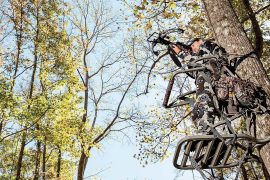
Man has always strived to be the best at what he does, and this same attitude applies to deer hunting, and more importantly, deer management. As a consequence of sportsmen’s insatiable desire to pursue larger-racked bucks and managers’ willingness to satisfy their requests, a variety of techniques have been tested to augment the size of those relished calcified appendages.
One of the most popular techniques employed is culling, which entails the harvest of bucks exhibiting less than desirable antler characteristics in order to allow those developing larger racks the opportunity to express those desirable traits through reproduction. But the question remains — is this concept effective, because it’s often employed simply as an excuse to shoot more bucks.
Based on my experience, culling has an indirect impact on overall antler quality, but not necessarily from the increased expressions of desirable genetic traits, but as a derivative of reducing a population that in most situations is excessive and extremely hard on the habitat, particularly those nutritious plants required to develop larger racks.
Increasing antler size on open land by culling is marginal at best, but it’s one method of removing additional animals, which always benefits both habitat and the inhabitants.
I have witnessed the positive effects of culling on confined herds on under 1,000 acres, but these herds are often provided a year- round supply of pelleted feed containing high amounts of crude protein, thus it’s hard to differentiate which had the greater impact on antler size, culling or the supplement.
The fact is if the correct genetic components occur in a deer herd, which they often do, all that is required is for the animal to age while benefitting from a nutritious diet on a consistent basis.

For example, on one 40,000-acre high-fenced ranch I work with, we have an estimated 2,124 deer (composed off 736 bucks, 720 does and 668 fawns). Based on as much as 50 percent of the herd could have been missed on our aerial helicopter survey, this number could possibly be doubled. More importantly, the observable density of 18.6 acres per deer is excessive, particularly when compared to the density of 33.6 acres per deer obtained in 2007 when I first surveyed the property.
But even at the present density, the number of exceptional bucks exhibiting antlers that gross score 160 inches or more is 13 times greater, with 92 trophy bucks observed in 2015 compared to only seven in 2007. Obviously, range condition in 2015 was exceptional, with much precipitation occurring during the spring and early summer when deer require it most for antler development.
But this moisture and the habitat it benefitted could not be able to compensate for the excessive population if it was not for the year-round feeding program consisting of 226 bulk feeders (one feeder per 175 acres). In other words, the carrying capacity of the land has not changed, but it has been artificially inflated by an ubiquitous feed source.
And even though a surplus of big bucks does occur, it comes with a very expensive price tag and not the removal of bucks exhibiting less than desirable headgear, particularly when only 52 bucks were removed as culls during the 2015 hunting season. The fact is if a consistently good weather pattern delivers ample rain to the brush country each spring, the abundance and quality of forage would, in my opinion, negate the requirement of culling, but drought in South Texas and northern Mexico is the norm….





